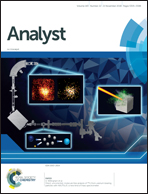Qualitative analysis of antibody–drug conjugates (ADCs): an experimental comparison of analytical techniques of cysteine-linked ADCs†
Abstract
Antibody–drug conjugates (ADCs) are an emerging type of biotherapeutics that utilize multiple tissue-specific antibodies combined with a range of linker designs to enable the transportation and selective release of cytotoxic drugs in close proximity to tumours. Consisting of antibodies conjugated to small drug molecules through a variety of linkers, ADCs are chemically complex analytes. Here we present a unique experimental comparison of four techniques for ADC analysis: hydrophobic interaction chromatography (HIC-UV/Vis), reversed phase liquid chromatography mass spectrometry (RPLC-MS), using either a QToF or an Orbitrap analyser, and matrix-assisted laser desorption ionization time-of-flight mass spectrometry (MALDI-TOF-MS). Four different ADCs consisting of Trastuzumab, monomethyl auristatin E (MMAE) and a peptidic linker moiety differing in their respective stoichiometric ratios in regard to drug-to-antibody ratio (DAR) were used for the comparison. We found that the determined DAR from all techniques was comparable, while the accuracy of the molecular weights for the conjugated light and heavy chain differed more extensively. This indicates that the choice of a mass analyser is more crucial for determining the accurate weights of the light and heavy chains than to evaluate the DAR of a given batch. However, ambiguous DAR assignment in HIC-UV/Vis or bias for either the light or heavy chain fragments in the mass spectrometry-based techniques can influence the obtained average DAR value and the use of complementary techniques is advisable. Out of the four techniques evaluated, HIC-UV/Vis and MALDI required less time to obtain an average DAR value and would therefore be good for initial screenings in the early stages of the discovery phase of new ADCs.



 Please wait while we load your content...
Please wait while we load your content...